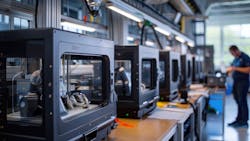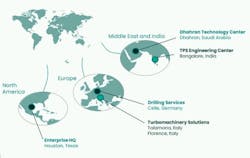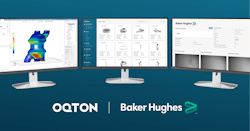How 3D Printing Fits into Manufacturing, For Real
Additive manufacturing enthusiasts, about 10 years ago, described a dream where 3D printing rose from rapid prototyping and design into a large-scale production technology. In 2024, financial challenges in the additive sector make that dream feel dead.
Additive does have a place in large manufacturing operations but in a role akin to 3D printing’s historical applications at scale, not mass production. Even limited use cases across an entire, worldwide manufacturing company provide challenging and complex processes.
Just ask Juan Carlos Flores, executive director for additive manufacturing at Baker Hughes.
Most of Flores’ 28-year career at Baker Hughes involved running oilfield services in Latin America, Southeast Asia, Russia and Europe. In 2013, after a short stint working in the Gulf of Mexico, Flores transitioned into product development, part of a technology team tasked with creating new services for the rapidly growing hydraulic fracturing (fracking) market across the United States – or “unconventionals” in oilpatch speak.
Also in 2013, Baker Hughes began playing with additive manufacturing, some polymer-based but mostly on the metals side. The technology was attractive but expensive.
In 2019, Baker Hughes asked Flores to assess whether the company should push ahead with additive and increase investment or step back and wait for the market to mature. In 2020, he formally took a position within the company’s additive manufacturing unit based in Houston, Texas.
Flores thinks his efforts still constitute an ongoing pilot. He may have laid down a blueprint for how additive realistically serves as a production technology for large companies, versus the dream sold to manufacturers more than a decade ago.
Learning the Limits: Additive in Production
Baker Hughes runs assembly and manufacturing plants and repair centers in almost two dozen countries around the world. The company has a comparatively small digital solution group but the bulk of its work concerns providing oilfield services and equipment.
Baker Hughes runs additive manufacturing centers in Texas, Germany, India, Italy and Saudi Arabia. If a plant cannot take advantage of local support centers, 3D printing requests go through Flores’ unit in Houston. It includes teams for engineering, production, materials development, project engineering and a digital team for dedicated IT support.
His production floor operates a variety of 3D printers representing different modalities including powder bed fusion, directed energy deposition and various polymer printing techniques. The shop prints up to 40 different parts in a given week, in batches as small as 10 or larger than 100.
When Flores took the helm in 2019, his unit devoted half its time and resources into R&D, developing basic understandings of the technologies, the differences between additive techniques and how best to use each. They also spent a significant amount of time developing and qualifying materials. Five years later, Flores and team devote 80% of their resources to production and only 20% into continued R&D.
Baker Hughes applies additive in three primary ways:
- Product Development: When new product development checks against different, potential methods of production, the list includes additive. In some cases, additive provides the only solution to address a specific engineering challenge. For example, a customer needed a part that could withstand very high pressures to seal a bore hole with very specific dimensions. Flores’ team developed a part with a flexible petal structure that traditional manufacturing couldn’t replicate. Originally developed for oil drilling, the part also can address similar problems in geothermal energy production.
- Training: Flores’ unit trains manufacturing and supply chain engineers in additive. Trying to identify from a single department in Houston the best use cases for additive, in a company with as large a global footprint as Baker Hughes, is unrealistic. It’s therefore up to local engineering and supply chain teams at various plants to assess which parts from their existing portfolios may benefit from additive.
“Every engineer has in their DNA trying to find a different way to solve the problem. So when they see that there is another tool available and we can actually teach them another way to solve some of the problems, we get a lot of requests for the training,” says Flores. - Supply Chain Resiliency: Flores and team provide one-off solutions if vendors that provide unique materials go out of business, or getting ahead of those risks by preparing just-in-case manufacturing options.
“One of our plants in Asia had a source material issue and a production run that was completely scrapped because it didn’t pass quality. … We found a solution that was going to be more expensive because we had to accelerate the qualification process, but we could at least help and support them [while they] transitioned to a new product. [But overall] we became so cost efficient that we became the first provider, the first option for that specific portfolio,” says Flores.
Even with three different methods of determining whether additive manufacturing presents appropriate solutions for a part, Flores says his team still only touches less than half a percent of all the parts manufactured by Baker Hughes. Trying to apply additive to the entire existing portfolio is impossible.
“We don’t have the manpower, the engineering capacity, to go through the legacy portfolio to explore opportunities. For, let’s say, 5,000 components or products that we have to screen, I’ll need 300 years of engineering for one person to dedicate for that portfolio.
“Also, the cost of the qualification of those portfolios is huge. If you change one manufacturing process in that portfolio, you will have to incur another qualification cost. … It doesn’t make any business sense to go back and check because the cost of the qualification will overwhelm the advantage of additively manufacturing it,” says Flores.
Think Additive, Think Data
Flores says requests come in for an average of 50 different parts a month. His unit manages a portfolio of more than 2,000 qualified parts, however, representing tremendous variables and resulting opportunities for error.
“When you have close to 2,000 parts qualified, somebody can call and tell you they want 10 of this part that was qualified years ago. You have to … repeat that process exactly as you qualified. The cost of qualification is…one of the most expensive things that we have in our portfolio. [To make sure] you don’t have to requalify every time, you want to use the same process that you did before and repeat it. You have to have 100% certain that you’re going to be able to do that again.”
Managing the data for a huge portfolio of additively manufacturing parts is unique, says Flores.
“The amount of data that we collect from the time we get a raw material to the time we actually release the [parts] is just insane. That’s why we have [a large] digital team. If we want to actually have traceability of that data to be able to produce the records that industries require, you need a system to create that traceability and find the data when you need it.”
His unit requires a dedicated IT team that understands how to design the required data structures and workflows for additive manufacturing, a task so challenging that it requires specialized 3D printer-agnostic software provided by 3D Systems subsidiary Oqton.
“If you want to do this in a serious way, you need to have a robust data structure to be able to understand how to leverage that. … When you say you have 2,000 files, it’s not 2,000 files. You have 2,000 containers of files, right? And those containers are from different enterprise systems [like customer service and engineering] across the company. To manipulate and handle that and make sure you do it right is very, very, very, data intensive.”
The Best Additive Will Ever Do?
In 2023, the Baker Hughes won Best Production Part at the Formnext Forum Austin additive manufacturing event. Flores’ unit seems like a highly successful endeavor that leaves little doubt about additive’s value as a full-on production technology. To Flores, however, his unit still remains a pilot project.
“Almost two years ago, the company made a decision to allocate our team under the supply chain structure and operational efficiency team. The pilot that before was R&D, supporting the company, became also a supply chain arm that can support the new initiative, but at the same time also evaluating…how can we actually convert this into an industrial process? I think that’s the journey that we are on right now, and we’re in the middle of it is. What are the barriers for this technology to come from an R&D environment to a real industrial, reliable and sustainable process?” says Flores.
“And when we tried to do that, we found that there were significant barriers on the level of immaturity of the technology to be able to convert it really into production, or sustainable long term production structure, and how that integrates to the rest of the process that you have in a very mature company.”
About the Author
Dennis Scimeca
Dennis Scimeca is a veteran technology journalist with particular experience in vision system technology, machine learning/artificial intelligence, and augmented/mixed/virtual reality (XR), with bylines in consumer, developer, and B2B outlets.
At IndustryWeek, he covers the competitive advantages gained by manufacturers that deploy proven technologies. If you would like to share your story with IndustryWeek, please contact Dennis at [email protected].



